Report: Analysis of Assessment Methods and Individual Learning Needs
VerifiedAdded on 2020/03/16
|10
|1878
|116
Report
AI Summary
This report provides a comprehensive analysis of various assessment methods used in higher education, exploring their roles and applications. It delves into the importance of initial and diagnostic assessments in understanding students' current capabilities and identifying their individual learning needs. The report further examines formative, summative, 'authentic' or work-integrated, dynamic, synoptic, criterion-referenced, and ipsative assessment methods. It highlights how these methods contribute to student learning, skill development, and the creation of personalized learning environments. The report also emphasizes the significance of aligning curriculum, cognitive processes, motivation, and management strategies to enhance student engagement and success. Finally, it advocates for a shift from a teacher-as-lecturer to a teacher-as-facilitator model to foster a more effective and supportive learning experience, ultimately preparing students for future academic and professional endeavors.
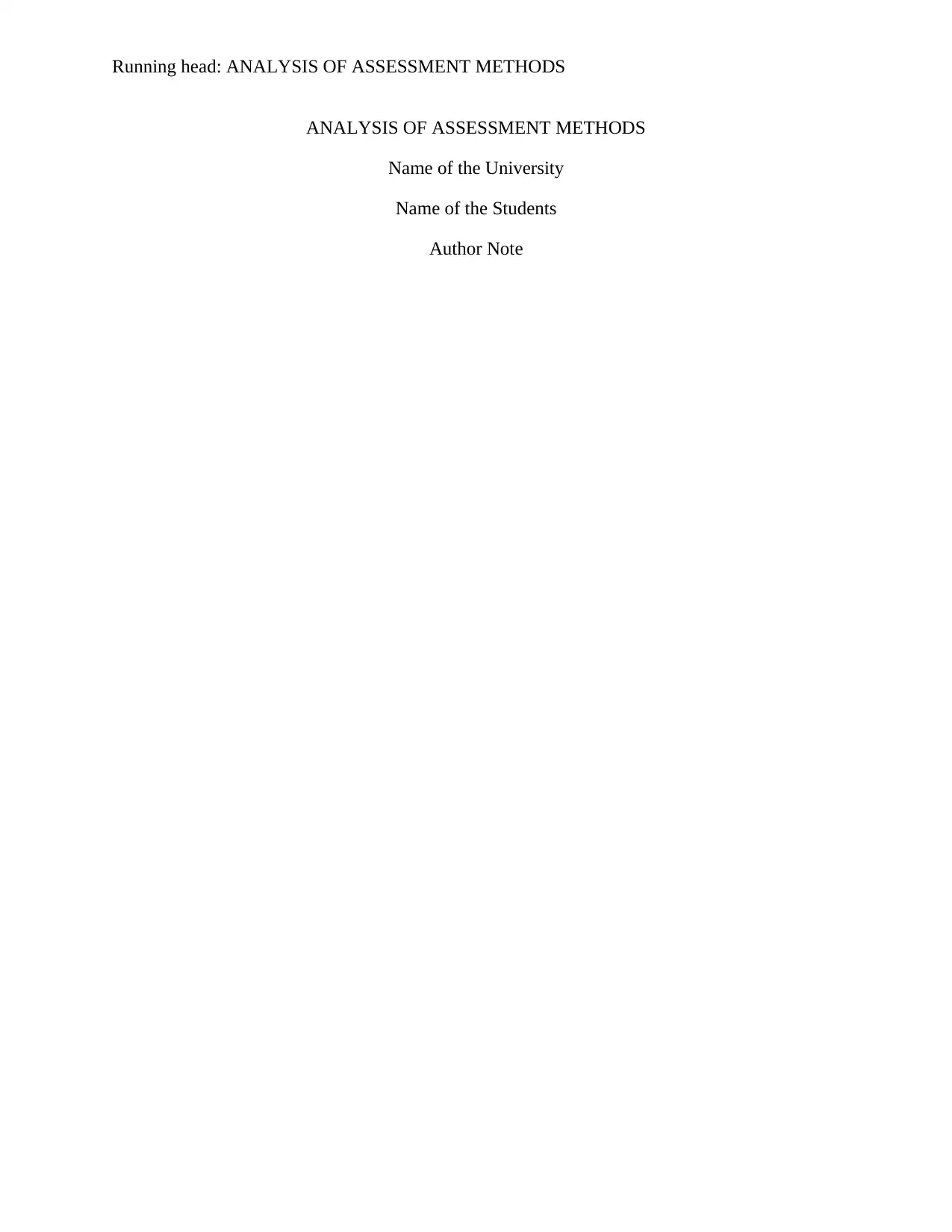
Running head: ANALYSIS OF ASSESSMENT METHODS
ANALYSIS OF ASSESSMENT METHODS
Name of the University
Name of the Students
Author Note
ANALYSIS OF ASSESSMENT METHODS
Name of the University
Name of the Students
Author Note
Paraphrase This Document
Need a fresh take? Get an instant paraphrase of this document with our AI Paraphraser
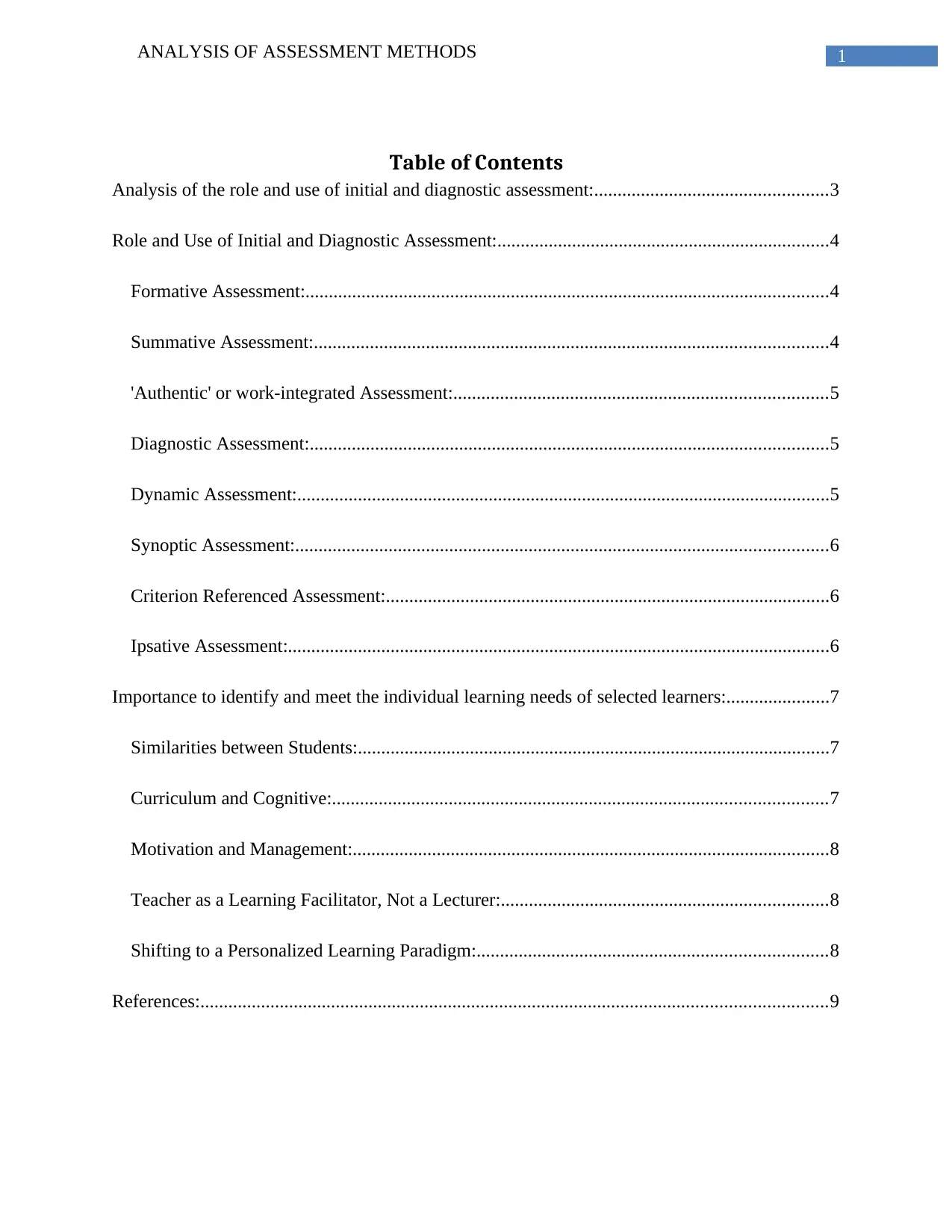
1ANALYSIS OF ASSESSMENT METHODS
Table of Contents
Analysis of the role and use of initial and diagnostic assessment:..................................................3
Role and Use of Initial and Diagnostic Assessment:.......................................................................4
Formative Assessment:................................................................................................................4
Summative Assessment:..............................................................................................................4
'Authentic' or work-integrated Assessment:................................................................................5
Diagnostic Assessment:...............................................................................................................5
Dynamic Assessment:..................................................................................................................5
Synoptic Assessment:..................................................................................................................6
Criterion Referenced Assessment:...............................................................................................6
Ipsative Assessment:....................................................................................................................6
Importance to identify and meet the individual learning needs of selected learners:......................7
Similarities between Students:.....................................................................................................7
Curriculum and Cognitive:..........................................................................................................7
Motivation and Management:......................................................................................................8
Teacher as a Learning Facilitator, Not a Lecturer:......................................................................8
Shifting to a Personalized Learning Paradigm:...........................................................................8
References:......................................................................................................................................9
Table of Contents
Analysis of the role and use of initial and diagnostic assessment:..................................................3
Role and Use of Initial and Diagnostic Assessment:.......................................................................4
Formative Assessment:................................................................................................................4
Summative Assessment:..............................................................................................................4
'Authentic' or work-integrated Assessment:................................................................................5
Diagnostic Assessment:...............................................................................................................5
Dynamic Assessment:..................................................................................................................5
Synoptic Assessment:..................................................................................................................6
Criterion Referenced Assessment:...............................................................................................6
Ipsative Assessment:....................................................................................................................6
Importance to identify and meet the individual learning needs of selected learners:......................7
Similarities between Students:.....................................................................................................7
Curriculum and Cognitive:..........................................................................................................7
Motivation and Management:......................................................................................................8
Teacher as a Learning Facilitator, Not a Lecturer:......................................................................8
Shifting to a Personalized Learning Paradigm:...........................................................................8
References:......................................................................................................................................9
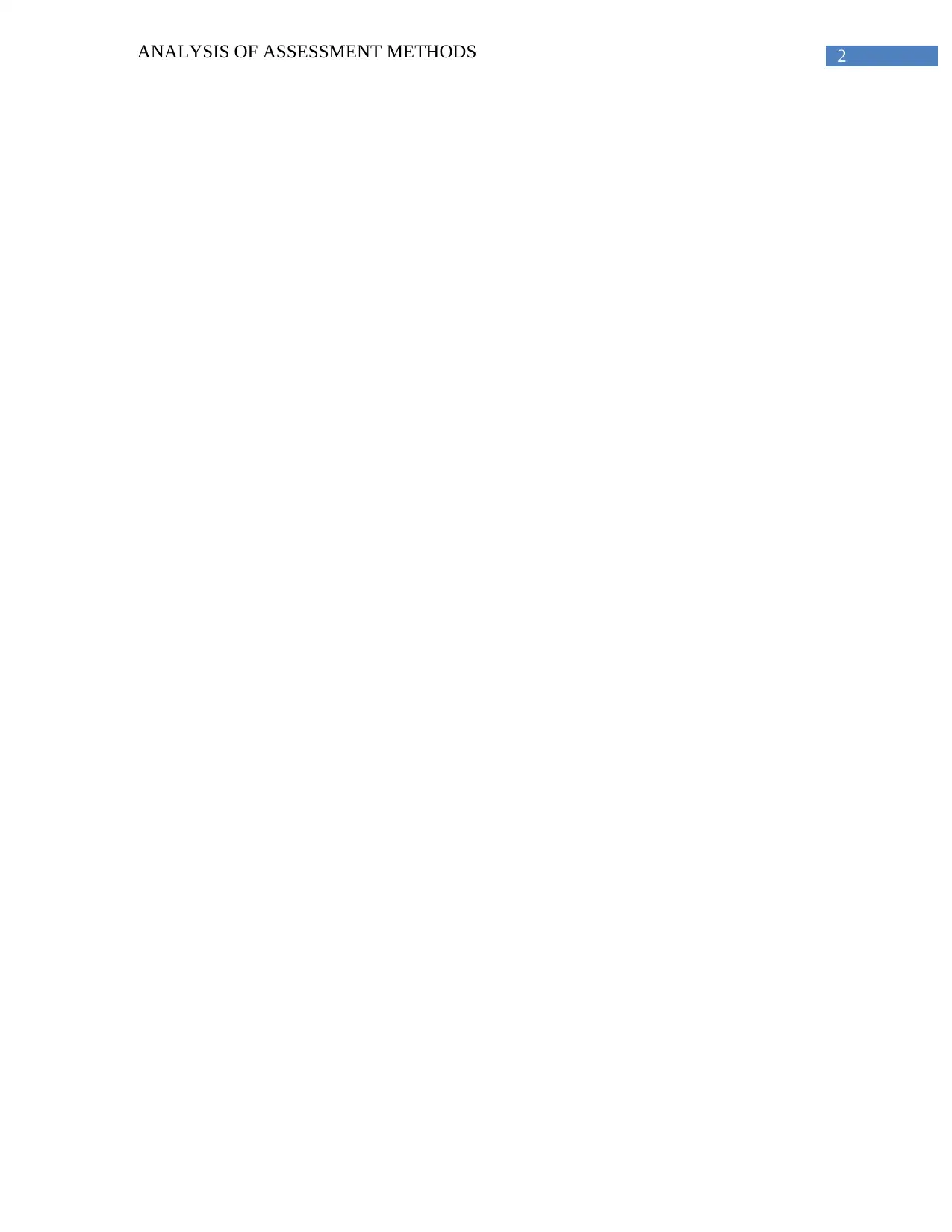
2ANALYSIS OF ASSESSMENT METHODS
⊘ This is a preview!⊘
Do you want full access?
Subscribe today to unlock all pages.

Trusted by 1+ million students worldwide
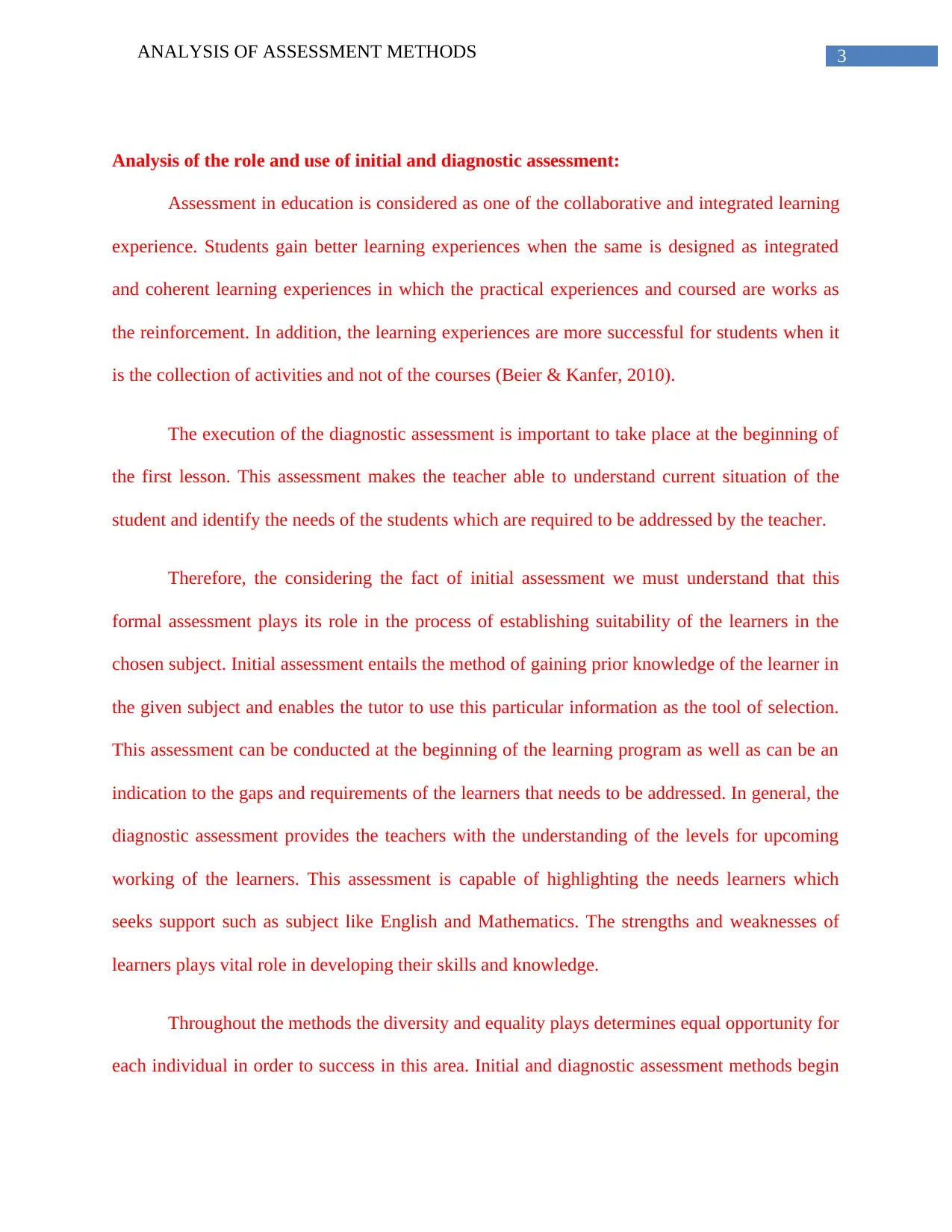
3ANALYSIS OF ASSESSMENT METHODS
Analysis of the role and use of initial and diagnostic assessment:
Assessment in education is considered as one of the collaborative and integrated learning
experience. Students gain better learning experiences when the same is designed as integrated
and coherent learning experiences in which the practical experiences and coursed are works as
the reinforcement. In addition, the learning experiences are more successful for students when it
is the collection of activities and not of the courses (Beier & Kanfer, 2010).
The execution of the diagnostic assessment is important to take place at the beginning of
the first lesson. This assessment makes the teacher able to understand current situation of the
student and identify the needs of the students which are required to be addressed by the teacher.
Therefore, the considering the fact of initial assessment we must understand that this
formal assessment plays its role in the process of establishing suitability of the learners in the
chosen subject. Initial assessment entails the method of gaining prior knowledge of the learner in
the given subject and enables the tutor to use this particular information as the tool of selection.
This assessment can be conducted at the beginning of the learning program as well as can be an
indication to the gaps and requirements of the learners that needs to be addressed. In general, the
diagnostic assessment provides the teachers with the understanding of the levels for upcoming
working of the learners. This assessment is capable of highlighting the needs learners which
seeks support such as subject like English and Mathematics. The strengths and weaknesses of
learners plays vital role in developing their skills and knowledge.
Throughout the methods the diversity and equality plays determines equal opportunity for
each individual in order to success in this area. Initial and diagnostic assessment methods begin
Analysis of the role and use of initial and diagnostic assessment:
Assessment in education is considered as one of the collaborative and integrated learning
experience. Students gain better learning experiences when the same is designed as integrated
and coherent learning experiences in which the practical experiences and coursed are works as
the reinforcement. In addition, the learning experiences are more successful for students when it
is the collection of activities and not of the courses (Beier & Kanfer, 2010).
The execution of the diagnostic assessment is important to take place at the beginning of
the first lesson. This assessment makes the teacher able to understand current situation of the
student and identify the needs of the students which are required to be addressed by the teacher.
Therefore, the considering the fact of initial assessment we must understand that this
formal assessment plays its role in the process of establishing suitability of the learners in the
chosen subject. Initial assessment entails the method of gaining prior knowledge of the learner in
the given subject and enables the tutor to use this particular information as the tool of selection.
This assessment can be conducted at the beginning of the learning program as well as can be an
indication to the gaps and requirements of the learners that needs to be addressed. In general, the
diagnostic assessment provides the teachers with the understanding of the levels for upcoming
working of the learners. This assessment is capable of highlighting the needs learners which
seeks support such as subject like English and Mathematics. The strengths and weaknesses of
learners plays vital role in developing their skills and knowledge.
Throughout the methods the diversity and equality plays determines equal opportunity for
each individual in order to success in this area. Initial and diagnostic assessment methods begin
Paraphrase This Document
Need a fresh take? Get an instant paraphrase of this document with our AI Paraphraser
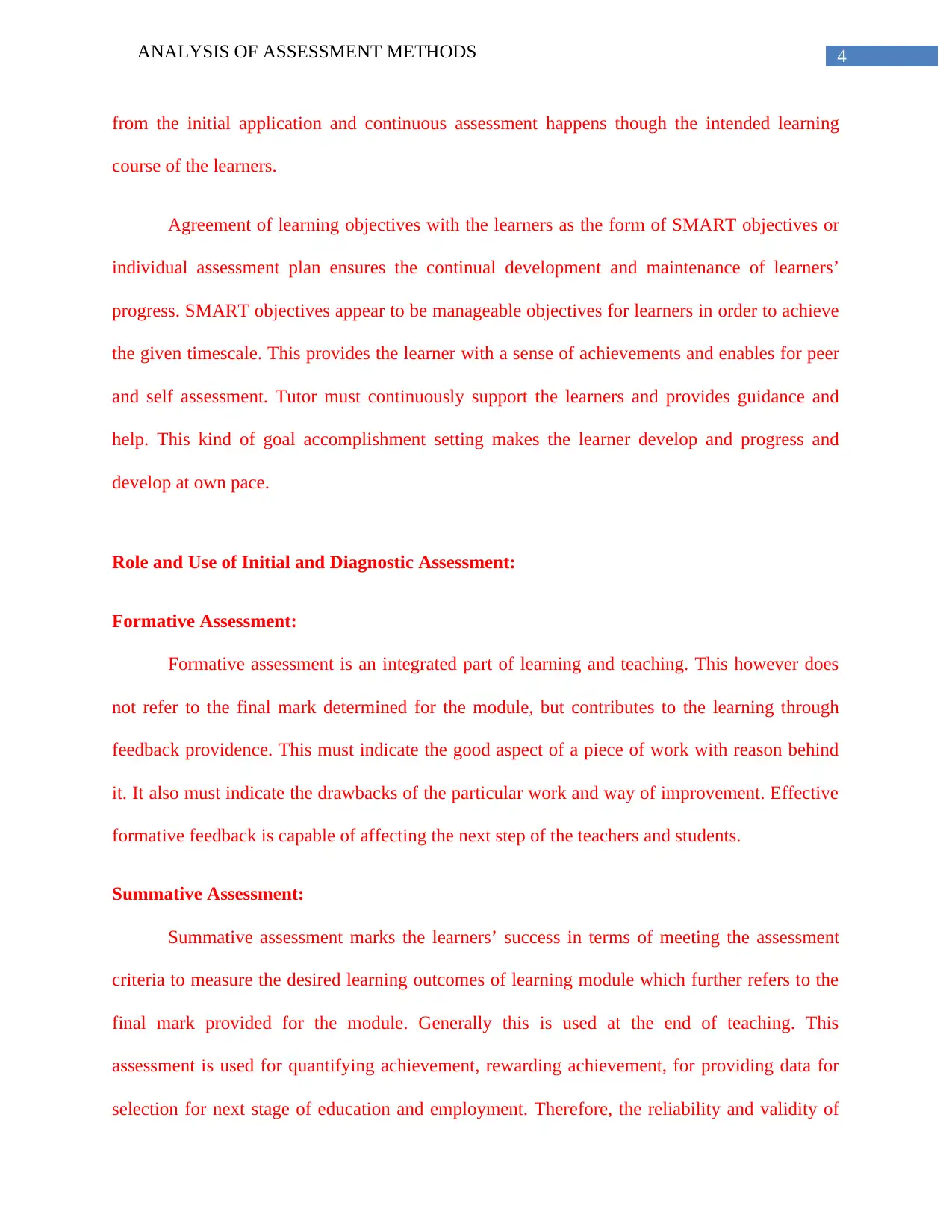
4ANALYSIS OF ASSESSMENT METHODS
from the initial application and continuous assessment happens though the intended learning
course of the learners.
Agreement of learning objectives with the learners as the form of SMART objectives or
individual assessment plan ensures the continual development and maintenance of learners’
progress. SMART objectives appear to be manageable objectives for learners in order to achieve
the given timescale. This provides the learner with a sense of achievements and enables for peer
and self assessment. Tutor must continuously support the learners and provides guidance and
help. This kind of goal accomplishment setting makes the learner develop and progress and
develop at own pace.
Role and Use of Initial and Diagnostic Assessment:
Formative Assessment:
Formative assessment is an integrated part of learning and teaching. This however does
not refer to the final mark determined for the module, but contributes to the learning through
feedback providence. This must indicate the good aspect of a piece of work with reason behind
it. It also must indicate the drawbacks of the particular work and way of improvement. Effective
formative feedback is capable of affecting the next step of the teachers and students.
Summative Assessment:
Summative assessment marks the learners’ success in terms of meeting the assessment
criteria to measure the desired learning outcomes of learning module which further refers to the
final mark provided for the module. Generally this is used at the end of teaching. This
assessment is used for quantifying achievement, rewarding achievement, for providing data for
selection for next stage of education and employment. Therefore, the reliability and validity of
from the initial application and continuous assessment happens though the intended learning
course of the learners.
Agreement of learning objectives with the learners as the form of SMART objectives or
individual assessment plan ensures the continual development and maintenance of learners’
progress. SMART objectives appear to be manageable objectives for learners in order to achieve
the given timescale. This provides the learner with a sense of achievements and enables for peer
and self assessment. Tutor must continuously support the learners and provides guidance and
help. This kind of goal accomplishment setting makes the learner develop and progress and
develop at own pace.
Role and Use of Initial and Diagnostic Assessment:
Formative Assessment:
Formative assessment is an integrated part of learning and teaching. This however does
not refer to the final mark determined for the module, but contributes to the learning through
feedback providence. This must indicate the good aspect of a piece of work with reason behind
it. It also must indicate the drawbacks of the particular work and way of improvement. Effective
formative feedback is capable of affecting the next step of the teachers and students.
Summative Assessment:
Summative assessment marks the learners’ success in terms of meeting the assessment
criteria to measure the desired learning outcomes of learning module which further refers to the
final mark provided for the module. Generally this is used at the end of teaching. This
assessment is used for quantifying achievement, rewarding achievement, for providing data for
selection for next stage of education and employment. Therefore, the reliability and validity of
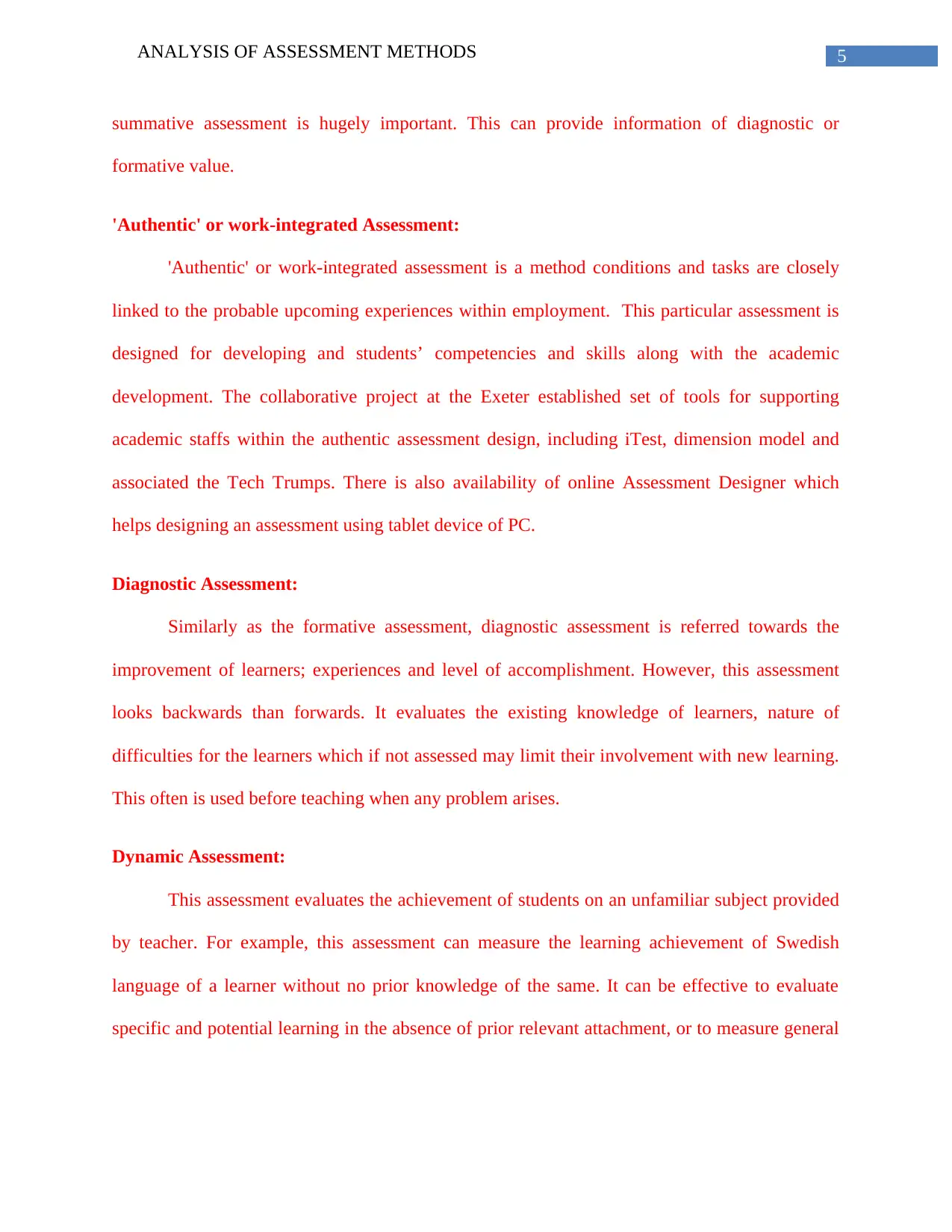
5ANALYSIS OF ASSESSMENT METHODS
summative assessment is hugely important. This can provide information of diagnostic or
formative value.
'Authentic' or work-integrated Assessment:
'Authentic' or work-integrated assessment is a method conditions and tasks are closely
linked to the probable upcoming experiences within employment. This particular assessment is
designed for developing and students’ competencies and skills along with the academic
development. The collaborative project at the Exeter established set of tools for supporting
academic staffs within the authentic assessment design, including iTest, dimension model and
associated the Tech Trumps. There is also availability of online Assessment Designer which
helps designing an assessment using tablet device of PC.
Diagnostic Assessment:
Similarly as the formative assessment, diagnostic assessment is referred towards the
improvement of learners; experiences and level of accomplishment. However, this assessment
looks backwards than forwards. It evaluates the existing knowledge of learners, nature of
difficulties for the learners which if not assessed may limit their involvement with new learning.
This often is used before teaching when any problem arises.
Dynamic Assessment:
This assessment evaluates the achievement of students on an unfamiliar subject provided
by teacher. For example, this assessment can measure the learning achievement of Swedish
language of a learner without no prior knowledge of the same. It can be effective to evaluate
specific and potential learning in the absence of prior relevant attachment, or to measure general
summative assessment is hugely important. This can provide information of diagnostic or
formative value.
'Authentic' or work-integrated Assessment:
'Authentic' or work-integrated assessment is a method conditions and tasks are closely
linked to the probable upcoming experiences within employment. This particular assessment is
designed for developing and students’ competencies and skills along with the academic
development. The collaborative project at the Exeter established set of tools for supporting
academic staffs within the authentic assessment design, including iTest, dimension model and
associated the Tech Trumps. There is also availability of online Assessment Designer which
helps designing an assessment using tablet device of PC.
Diagnostic Assessment:
Similarly as the formative assessment, diagnostic assessment is referred towards the
improvement of learners; experiences and level of accomplishment. However, this assessment
looks backwards than forwards. It evaluates the existing knowledge of learners, nature of
difficulties for the learners which if not assessed may limit their involvement with new learning.
This often is used before teaching when any problem arises.
Dynamic Assessment:
This assessment evaluates the achievement of students on an unfamiliar subject provided
by teacher. For example, this assessment can measure the learning achievement of Swedish
language of a learner without no prior knowledge of the same. It can be effective to evaluate
specific and potential learning in the absence of prior relevant attachment, or to measure general
⊘ This is a preview!⊘
Do you want full access?
Subscribe today to unlock all pages.

Trusted by 1+ million students worldwide
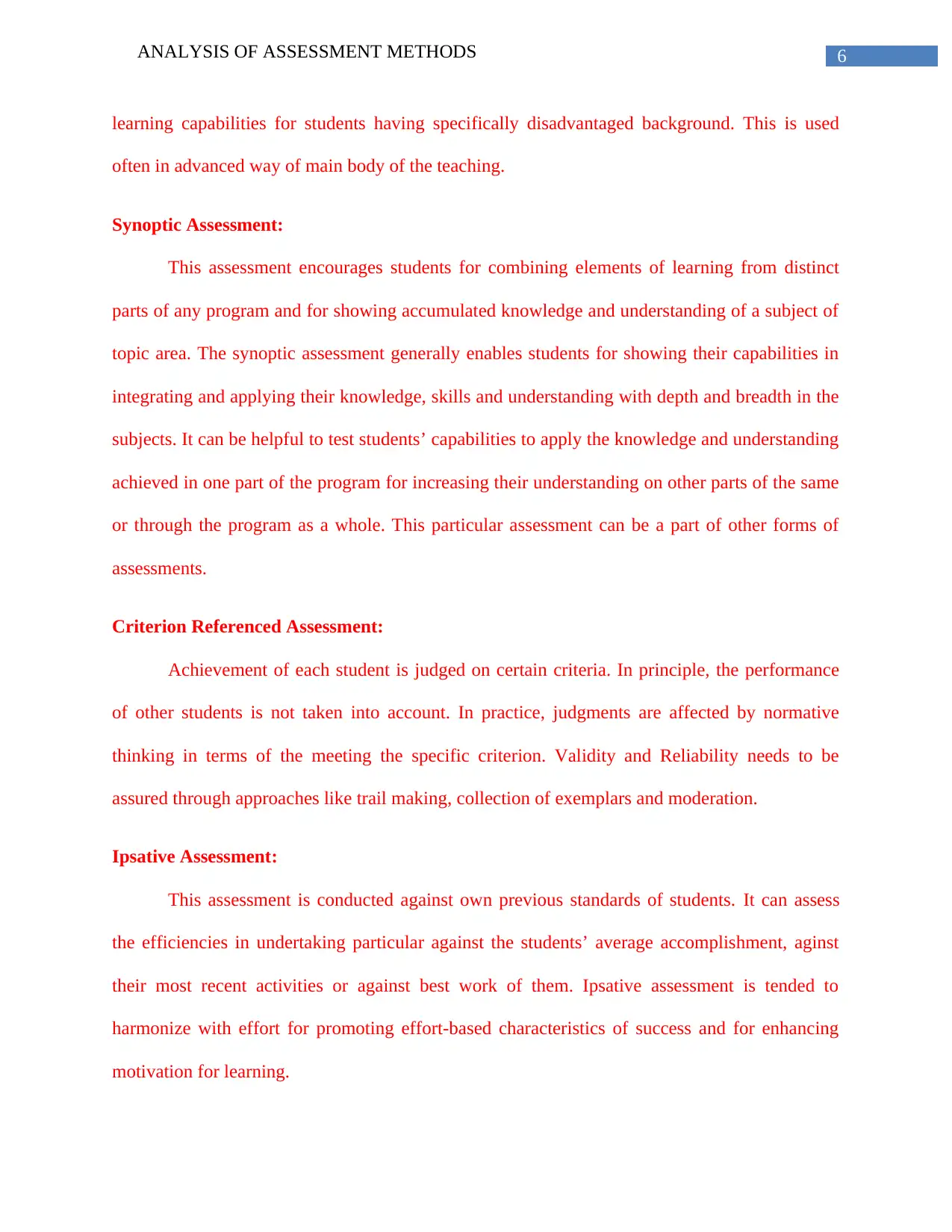
6ANALYSIS OF ASSESSMENT METHODS
learning capabilities for students having specifically disadvantaged background. This is used
often in advanced way of main body of the teaching.
Synoptic Assessment:
This assessment encourages students for combining elements of learning from distinct
parts of any program and for showing accumulated knowledge and understanding of a subject of
topic area. The synoptic assessment generally enables students for showing their capabilities in
integrating and applying their knowledge, skills and understanding with depth and breadth in the
subjects. It can be helpful to test students’ capabilities to apply the knowledge and understanding
achieved in one part of the program for increasing their understanding on other parts of the same
or through the program as a whole. This particular assessment can be a part of other forms of
assessments.
Criterion Referenced Assessment:
Achievement of each student is judged on certain criteria. In principle, the performance
of other students is not taken into account. In practice, judgments are affected by normative
thinking in terms of the meeting the specific criterion. Validity and Reliability needs to be
assured through approaches like trail making, collection of exemplars and moderation.
Ipsative Assessment:
This assessment is conducted against own previous standards of students. It can assess
the efficiencies in undertaking particular against the students’ average accomplishment, aginst
their most recent activities or against best work of them. Ipsative assessment is tended to
harmonize with effort for promoting effort-based characteristics of success and for enhancing
motivation for learning.
learning capabilities for students having specifically disadvantaged background. This is used
often in advanced way of main body of the teaching.
Synoptic Assessment:
This assessment encourages students for combining elements of learning from distinct
parts of any program and for showing accumulated knowledge and understanding of a subject of
topic area. The synoptic assessment generally enables students for showing their capabilities in
integrating and applying their knowledge, skills and understanding with depth and breadth in the
subjects. It can be helpful to test students’ capabilities to apply the knowledge and understanding
achieved in one part of the program for increasing their understanding on other parts of the same
or through the program as a whole. This particular assessment can be a part of other forms of
assessments.
Criterion Referenced Assessment:
Achievement of each student is judged on certain criteria. In principle, the performance
of other students is not taken into account. In practice, judgments are affected by normative
thinking in terms of the meeting the specific criterion. Validity and Reliability needs to be
assured through approaches like trail making, collection of exemplars and moderation.
Ipsative Assessment:
This assessment is conducted against own previous standards of students. It can assess
the efficiencies in undertaking particular against the students’ average accomplishment, aginst
their most recent activities or against best work of them. Ipsative assessment is tended to
harmonize with effort for promoting effort-based characteristics of success and for enhancing
motivation for learning.
Paraphrase This Document
Need a fresh take? Get an instant paraphrase of this document with our AI Paraphraser
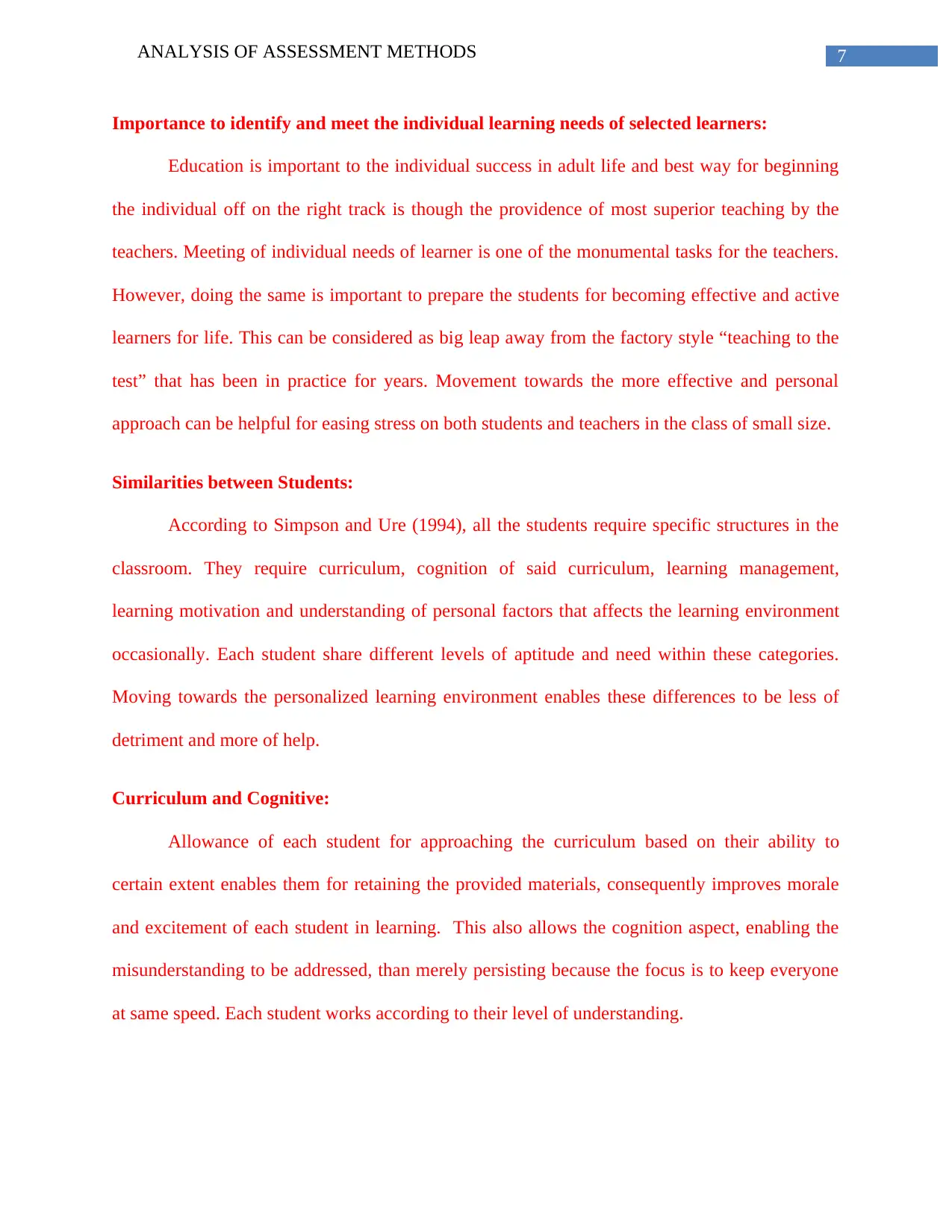
7ANALYSIS OF ASSESSMENT METHODS
Importance to identify and meet the individual learning needs of selected learners:
Education is important to the individual success in adult life and best way for beginning
the individual off on the right track is though the providence of most superior teaching by the
teachers. Meeting of individual needs of learner is one of the monumental tasks for the teachers.
However, doing the same is important to prepare the students for becoming effective and active
learners for life. This can be considered as big leap away from the factory style “teaching to the
test” that has been in practice for years. Movement towards the more effective and personal
approach can be helpful for easing stress on both students and teachers in the class of small size.
Similarities between Students:
According to Simpson and Ure (1994), all the students require specific structures in the
classroom. They require curriculum, cognition of said curriculum, learning management,
learning motivation and understanding of personal factors that affects the learning environment
occasionally. Each student share different levels of aptitude and need within these categories.
Moving towards the personalized learning environment enables these differences to be less of
detriment and more of help.
Curriculum and Cognitive:
Allowance of each student for approaching the curriculum based on their ability to
certain extent enables them for retaining the provided materials, consequently improves morale
and excitement of each student in learning. This also allows the cognition aspect, enabling the
misunderstanding to be addressed, than merely persisting because the focus is to keep everyone
at same speed. Each student works according to their level of understanding.
Importance to identify and meet the individual learning needs of selected learners:
Education is important to the individual success in adult life and best way for beginning
the individual off on the right track is though the providence of most superior teaching by the
teachers. Meeting of individual needs of learner is one of the monumental tasks for the teachers.
However, doing the same is important to prepare the students for becoming effective and active
learners for life. This can be considered as big leap away from the factory style “teaching to the
test” that has been in practice for years. Movement towards the more effective and personal
approach can be helpful for easing stress on both students and teachers in the class of small size.
Similarities between Students:
According to Simpson and Ure (1994), all the students require specific structures in the
classroom. They require curriculum, cognition of said curriculum, learning management,
learning motivation and understanding of personal factors that affects the learning environment
occasionally. Each student share different levels of aptitude and need within these categories.
Moving towards the personalized learning environment enables these differences to be less of
detriment and more of help.
Curriculum and Cognitive:
Allowance of each student for approaching the curriculum based on their ability to
certain extent enables them for retaining the provided materials, consequently improves morale
and excitement of each student in learning. This also allows the cognition aspect, enabling the
misunderstanding to be addressed, than merely persisting because the focus is to keep everyone
at same speed. Each student works according to their level of understanding.
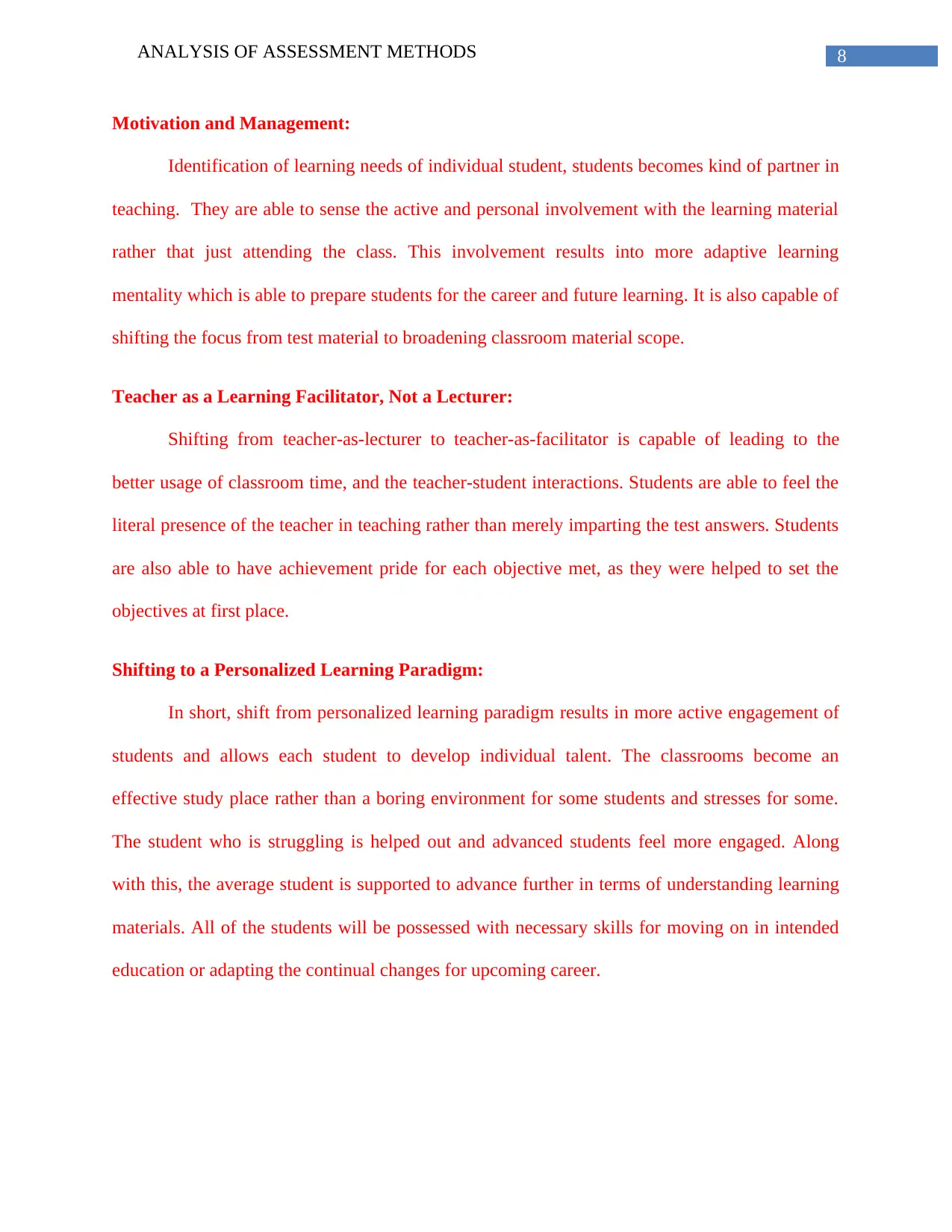
8ANALYSIS OF ASSESSMENT METHODS
Motivation and Management:
Identification of learning needs of individual student, students becomes kind of partner in
teaching. They are able to sense the active and personal involvement with the learning material
rather that just attending the class. This involvement results into more adaptive learning
mentality which is able to prepare students for the career and future learning. It is also capable of
shifting the focus from test material to broadening classroom material scope.
Teacher as a Learning Facilitator, Not a Lecturer:
Shifting from teacher-as-lecturer to teacher-as-facilitator is capable of leading to the
better usage of classroom time, and the teacher-student interactions. Students are able to feel the
literal presence of the teacher in teaching rather than merely imparting the test answers. Students
are also able to have achievement pride for each objective met, as they were helped to set the
objectives at first place.
Shifting to a Personalized Learning Paradigm:
In short, shift from personalized learning paradigm results in more active engagement of
students and allows each student to develop individual talent. The classrooms become an
effective study place rather than a boring environment for some students and stresses for some.
The student who is struggling is helped out and advanced students feel more engaged. Along
with this, the average student is supported to advance further in terms of understanding learning
materials. All of the students will be possessed with necessary skills for moving on in intended
education or adapting the continual changes for upcoming career.
Motivation and Management:
Identification of learning needs of individual student, students becomes kind of partner in
teaching. They are able to sense the active and personal involvement with the learning material
rather that just attending the class. This involvement results into more adaptive learning
mentality which is able to prepare students for the career and future learning. It is also capable of
shifting the focus from test material to broadening classroom material scope.
Teacher as a Learning Facilitator, Not a Lecturer:
Shifting from teacher-as-lecturer to teacher-as-facilitator is capable of leading to the
better usage of classroom time, and the teacher-student interactions. Students are able to feel the
literal presence of the teacher in teaching rather than merely imparting the test answers. Students
are also able to have achievement pride for each objective met, as they were helped to set the
objectives at first place.
Shifting to a Personalized Learning Paradigm:
In short, shift from personalized learning paradigm results in more active engagement of
students and allows each student to develop individual talent. The classrooms become an
effective study place rather than a boring environment for some students and stresses for some.
The student who is struggling is helped out and advanced students feel more engaged. Along
with this, the average student is supported to advance further in terms of understanding learning
materials. All of the students will be possessed with necessary skills for moving on in intended
education or adapting the continual changes for upcoming career.
⊘ This is a preview!⊘
Do you want full access?
Subscribe today to unlock all pages.

Trusted by 1+ million students worldwide
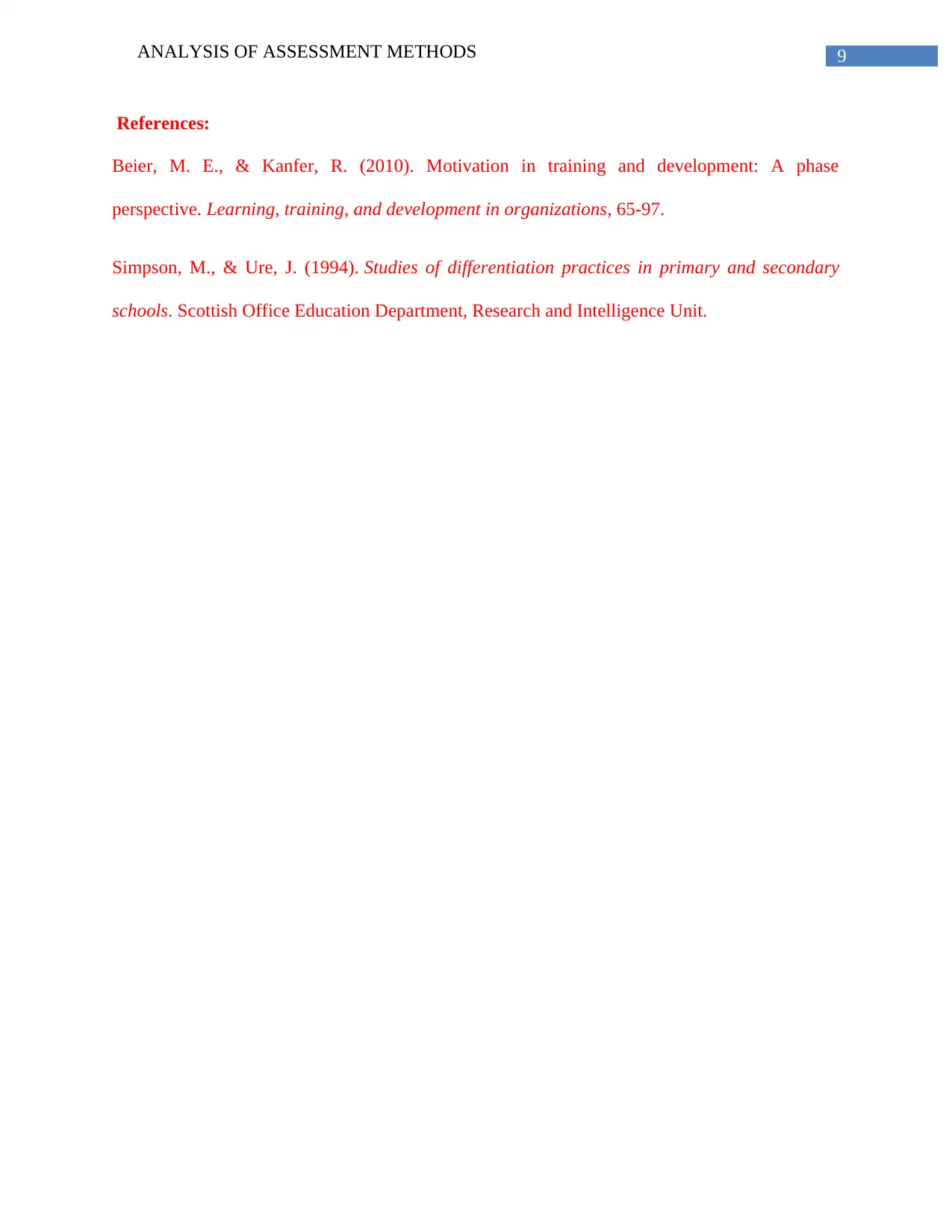
9ANALYSIS OF ASSESSMENT METHODS
References:
Beier, M. E., & Kanfer, R. (2010). Motivation in training and development: A phase
perspective. Learning, training, and development in organizations, 65-97.
Simpson, M., & Ure, J. (1994). Studies of differentiation practices in primary and secondary
schools. Scottish Office Education Department, Research and Intelligence Unit.
References:
Beier, M. E., & Kanfer, R. (2010). Motivation in training and development: A phase
perspective. Learning, training, and development in organizations, 65-97.
Simpson, M., & Ure, J. (1994). Studies of differentiation practices in primary and secondary
schools. Scottish Office Education Department, Research and Intelligence Unit.
1 out of 10
Related Documents
Your All-in-One AI-Powered Toolkit for Academic Success.
+13062052269
info@desklib.com
Available 24*7 on WhatsApp / Email
![[object Object]](/_next/static/media/star-bottom.7253800d.svg)
Unlock your academic potential
Copyright © 2020–2025 A2Z Services. All Rights Reserved. Developed and managed by ZUCOL.




